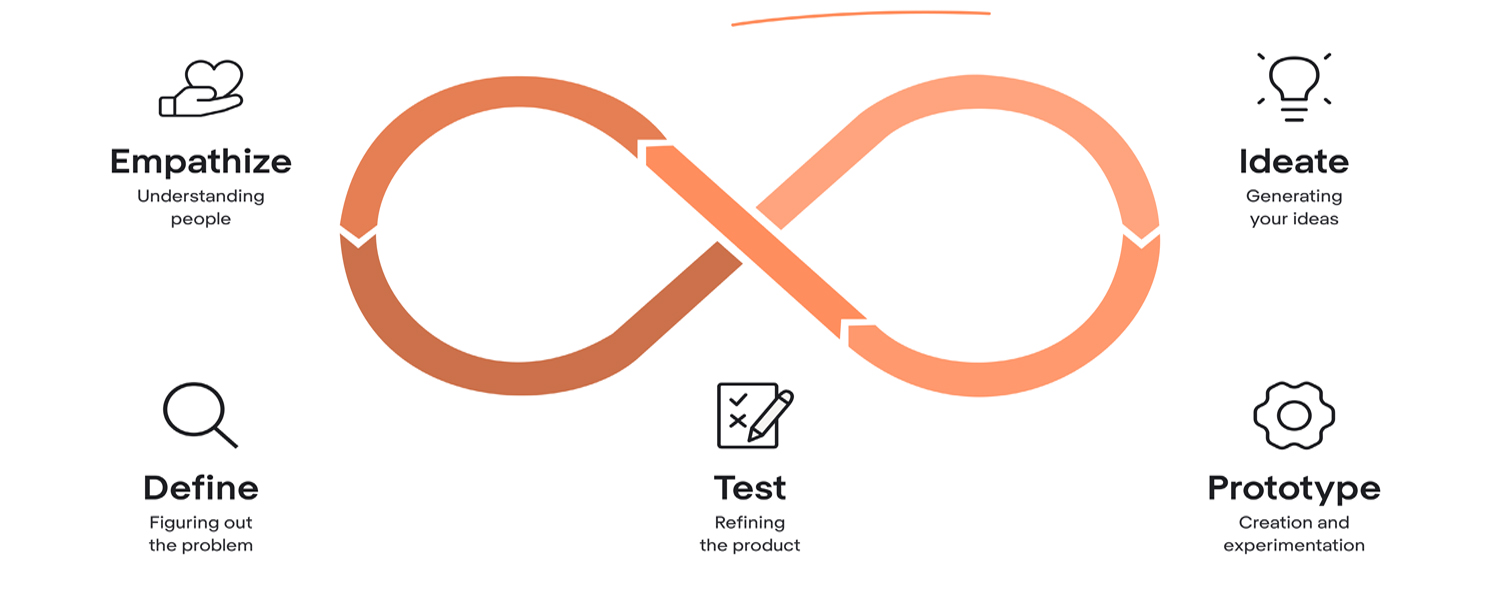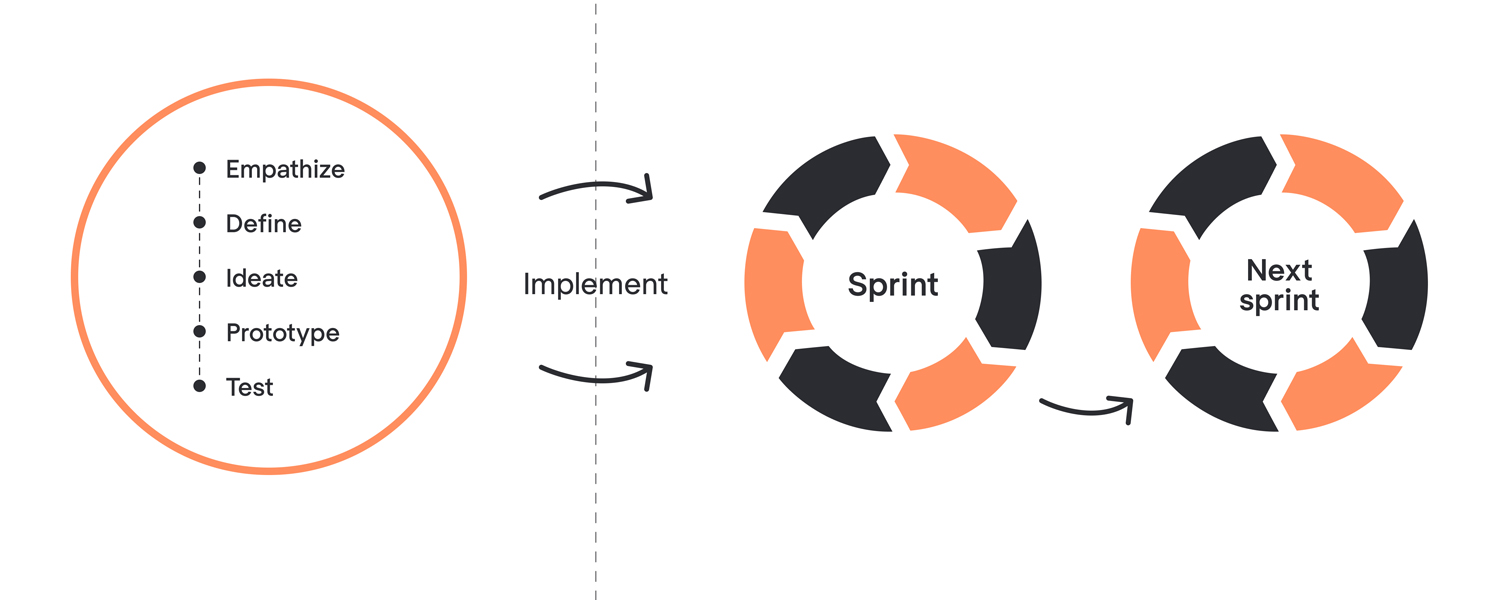The Intersection of Agile and Design Thinking | A Winning Combination
Feb 17, 2025
In today’s fast-paced market, businesses must balance speed and innovation to create meaningful, user-driven solutions. Agile emphasizes rapid, iterative development, while Design Thinking focuses on deep user research and creative problem-solving. However, when used separately, teams struggle to integrate innovation with execution.
By combining Agile and Design Thinking, organizations can enhance collaboration, improve user-centricity, and drive continuous innovation. This synergy ensures that development remains flexible while addressing real customer needs.
This article explores how integrating Design Thinking in Agile projects helps overcome common challenges, such as ineffective user feedback and misalignment between ideation and execution. Discover best practices for creating a customer-centric Agile innovation framework that balances iterative delivery with meaningful problem-solving.

Overcoming the Misalignment Between Agile and Design Thinking
Agile and Design Thinking are both powerful frameworks for product development, yet they often operate in silos due to their different focus areas. Agile emphasizes rapid, iterative delivery, while design thinking prioritizes deep user research and creative ideation.
This divergence can create a misalignment between development teams focused on execution and designers aiming for innovation.
The core challenge lies in balancing customer-centric Agile development with the exploratory nature of Design Thinking in Agile projects. Without integration, teams risk overlooking user needs in favor of speed or, conversely, delaying development due to prolonged ideation.
Causes of Misalignment
- Different Focus Areas – Agile focuses on delivering working software in short cycles, whereas Design Thinking explores user problems before committing to solutions. This fundamental difference can lead to friction when trying to implement customer feedback within Agile sprints.
- Siloed Teams – In many organizations, Agile teams operate separately from UX designers and researchers. This separation results in communication gaps, limiting the effectiveness of customer insights in Agile innovation frameworks.
- Iterative vs. Holistic Approach – Agile follows incremental development cycles, which can struggle to incorporate the holistic, exploratory nature of Design Thinking without disrupting sprint-based workflows.
Solutions | Bridging Agile and Design Thinking
To effectively integrate Agile with Design Thinking, organizations must establish a seamless workflow that embraces both methodologies. Here’s how:
Foster Cross-Functional Collaboration
Encouraging collaboration between designers, developers, and product managers is essential for bridging the Agile-Design Thinking gap. Embedding designers within Agile teams ensure continuous user research and validation rather than confining Design Thinking to the initial project phase.
Establish Shared Goals and Timelines
To align Agile with Design Thinking, teams must define shared objectives that balance rapid iterations with customer-centric problem-solving. Instead of treating user research as a separate phase, integrating it into Agile sprints allows teams to refine their understanding of user needs without disrupting development.
Implement a Dual Approach Framework
An Agile innovation framework that incorporates Design Thinking principles—such as Google’s Design Sprint or Lean UX—can help maintain a balance between iteration and ideation. This approach ensures that customer insights continuously inform development, leading to a more user-centric Agile process.
Encourage a Customer-First Mindset
Adopting a mindset that prioritizes user needs over rigid Agile timelines helps teams embrace continuous discovery and improvement. Encouraging regular feedback loops, prototyping, and empathy-driven problem-solving enables Agile teams to remain adaptable while staying user-focused.

Enhancing User Feedback Integration in Agile and Design Thinking
One of the biggest obstacles in Agile and Design Thinking integration is the ineffective incorporation of user feedback. Agile emphasizes iterative development, while design thinking focuses on deep user insights.
However, when structured feedback loops are missing or user insights are ignored, teams risk building products that fail to meet real user needs. This disconnect leads to wasted resources, increased rework, and customer dissatisfaction.
Causes of Ineffective User Feedback Integration
- Lack of Structured Feedback Loops – Teams struggle to make meaningful improvements without a systematic approach to collecting, analyzing, and implementing feedback. Agile’s rapid sprints often leave little room for thorough user research.
- Ignoring End-User Insights – Teams may prioritize internal assumptions over actual user needs due to time constraints or stakeholder pressure. This results in products that are misaligned with user expectations.
- Delays in Feedback Implementation – Even when user feedback is gathered, integrating it into ongoing Agile sprints can be challenging. If feedback is not addressed promptly, issues persist, leading to inefficiencies.
Solutions | Strengthening User Feedback Loops
Introduce Rapid Prototyping
Rapid prototyping allows teams to visualize solutions early and refine them based on user input before investing heavily in development. By leveraging low-fidelity wireframes or interactive mockups, teams can validate ideas quickly and minimize risks.
Conduct Frequent User Testing
Frequent user testing should be embedded within Agile sprints to ensure continuous improvement. Techniques like usability testing, A/B testing, and in-depth user interviews help capture real-world insights. The key is to test with real users at various stages of the development cycle rather than waiting until the final product is built.
Adjust Sprint Goals Based on Feedback
To integrate design thinking in Agile projects, sprint goals must remain flexible to accommodate evolving user needs. Teams should prioritize high-impact feedback and adjust backlog items accordingly. Using frameworks like Lean UX or continuous discovery ensures user insights remain at the forefront of decision-making.
Balancing Speed and Innovation in Agile and Design Thinking
One of the biggest struggles in integrating Agile with Design Thinking is balancing the need for speed with the demand for innovation. Agile is built for rapid, incremental delivery, whereas Design Thinking emphasizes deep exploration and creativity. When teams prioritize speed over innovation, they risk releasing products that lack user-centric solutions. Conversely, overemphasizing exploration can slow down development, leading to missed deadlines and inefficiencies.
Causes of the Imbalance
- Pressure to Deliver Quickly – Agile methodologies focus on rapid iterations and short development cycles, often pushing teams to prioritize delivery over user research and innovation. This leads to rushed decisions and surface-level solutions.
- Insufficient Time for Exploration – Innovation requires time for ideation, prototyping, and testing. When teams operate under strict sprint deadlines, they often sacrifice discovery phases, resulting in products that may not fully address user needs.
Solutions | Integrating Speed and Innovation
Allocate Time for Discovery Phases
To ensure innovation isn’t compromised, teams should integrate dedicated discovery phases before committing to development. These phases allow for in-depth user research, problem framing, and concept validation, ensuring Agile sprints are built on well-defined insights.
Include Design Sprints Before Agile Sprints
A structured approach to balancing innovation with speed is using Design Sprints—a five-day process to rapidly prototype and validate ideas. Design Sprints help teams refine concepts before they enter Agile sprints, reducing rework and ensuring solutions are user-driven from the start.
Implement Dual-Track Agile
Dual-Track Agile separates discovery (research, ideation, and prototyping) from delivery (building and iterating). This approach enables continuous innovation without slowing down development, ensuring teams maintain both user-centricity and speed.
Overcoming Resistance to a Customer-Centric Mindset in Agile and Design Thinking
One of the key obstacles in integrating Agile with Design Thinking is the resistance to adopting a customer-centric mindset. Many Agile teams focus on delivery speed, technical feasibility, and internal business priorities, often overlooking user needs. This traditional development focus leads to products that may be functional but fail to create meaningful user experiences. Without a deep understanding of users, teams struggle to align their work with real-world problems, reducing the impact of Agile innovation frameworks.
Causes of Resistance
- Traditional Development Focus – Many organizations still follow a feature-driven approach rather than a problem-solving one. Teams often prioritize meeting deadlines and technical goals over understanding customer pain points.
- Lack of User Empathy – Developers and product managers may have limited exposure to real users, relying on assumptions rather than direct insights. This gap leads to products that miss the mark in addressing user needs.

Solutions | Embedding a Customer-First Approach
Conduct Empathy Mapping Workshops
Empathy mapping is a powerful Design Thinking tool that helps teams step into the user’s shoes. By visualizing what users think, feel, see, and do, teams can develop a deeper understanding of their frustrations and motivations. Regular empathy workshops before or during Agile sprints ensure that development decisions are rooted in real user experiences.
Integrate Customer Personas in Sprint Planning
Customer personas provide a tangible representation of user segments, ensuring that Agile teams consistently consider user needs. By incorporating personas into sprint planning sessions, teams can evaluate whether their backlog items and priorities align with the needs of different user groups. This approach bridges the gap between Agile execution and Design Thinking’s user-centered approach.
Foster a Culture of Continuous User Feedback
Building a customer-first mindset requires ongoing exposure to user feedback. Conducting usability testing, gathering real-world insights through interviews, and using data-driven decision-making ensure that Agile teams stay connected to their users beyond just initial research phases.

Addressing the Challenge of Unclear User Needs in Agile and Design Thinking
A critical challenge in integrating Agile with Design Thinking is the unclear definition of user needs. Agile relies on rapid iterations, but without a clear understanding of user problems, teams risk building solutions that don’t address real pain points. Design Thinking, on the other hand, focuses on deep user research and problem framing.
When these two approaches are not aligned, Agile teams may work with ambiguous problem statements, leading to wasted effort and misaligned solutions.
Causes of Unclear User Needs
- Insufficient Research – Agile’s fast-paced nature often limits the time available for thorough user research. Without deep insights, teams may rely on assumptions rather than real data.
- Ambiguous Problem Statements – Jumping straight into development without clearly defining the problem can lead to vague requirements. This results in features that may not truly solve user challenges.
Solutions | Clarifying User Needs Before Development
Use Design Thinking Tools Like Journey Maps
Customer journey maps provide a visual representation of user experiences, emotions, and pain points across different touchpoints. By mapping out the user’s interactions with a product or service, teams can better understand where improvements are needed. This structured approach helps Agile teams prioritize development efforts based on real user challenges.
Ensure Problem Framing Before Solution Development
Before jumping into Agile sprints, teams should invest time in problem framing to align on the core issue they are solving. Using frameworks like the "How Might We" method or problem statements, teams can refine their understanding of user needs before committing to solutions. This step ensures that Agile iterations remain focused on solving well-defined problems rather than chasing unclear requirements.
Combine Research with Agile Development
To avoid knowledge gaps, teams should incorporate continuous user research alongside Agile sprints. Conducting user interviews, usability testing, and surveys in parallel with development ensures that evolving user needs are continuously validated and refined.
FAQs
How do Agile and Design Thinking complement each other?
Agile focuses on rapid, iterative development, while Design Thinking emphasizes deep user research and problem-solving. Combining them ensures both speed and user-centric innovation.
What are the key challenges in integrating Agile with Design Thinking?
Common challenges include misalignment between fast iterations and deep ideation, ineffective user feedback incorporation, and resistance to a customer-first mindset.
How can teams balance speed and innovation in Agile projects?
By allocating time for discovery phases, conducting Design Sprints before Agile sprints, and using frameworks like Dual-Track Agile to separate exploration from execution.
What are the benefits of combining Agile and Design Thinking?
It enhances collaboration, improves product-market fit, ensures continuous user validation, and creates a more adaptive and customer-centric development process.
Bottom Line
Integrating Agile and Design Thinking creates a powerful synergy that balances speed, innovation, and user-centricity. While Agile ensures rapid, iterative development, Design Thinking brings deep user insights and problem-solving into the process. By overcoming challenges like ineffective feedback loops and misalignment between ideation and execution, teams can build customer-driven, high-impact solutions.
Embracing this combined approach fosters collaboration, adaptability, and continuous innovation, helping businesses stay ahead in today’s competitive landscape. Organizations that successfully integrate Design Thinking in Agile projects will not only enhance product quality but also deliver solutions that truly resonate with users.
Stay connected with news and updates!
Join our mailing list to receive the latest news and updates from our team.
Don't worry, your information will not be shared.
We hate SPAM. We will never sell your information, for any reason.

